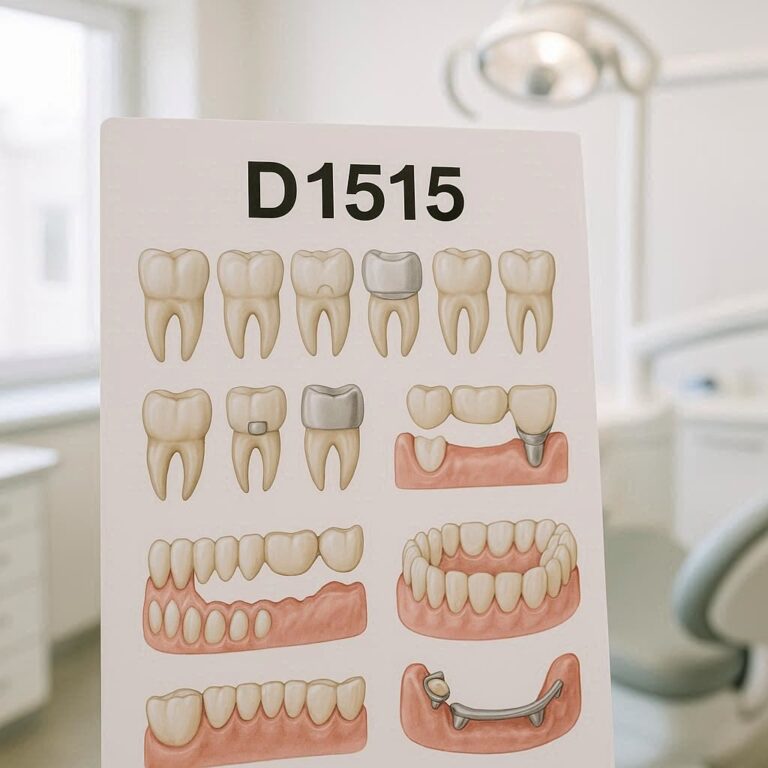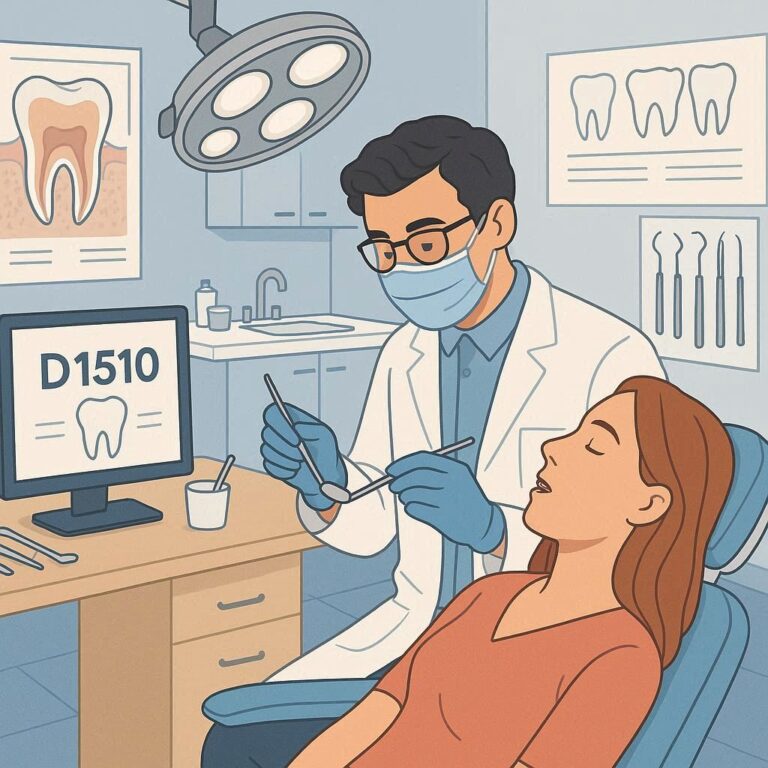Understanding the D6112 Dental Code
1. What is the D6112 Dental Code?
The D6112 dental code is part of the Current Dental Terminology (CDT) code set, specifically related to implant-supported prosthetics. This code is used to document and bill for implant-supported dentures for edentulous patients, particularly those requiring fixed partial dentures on two or more implants. Understanding this code is essential for accurate billing, compliance, and ensuring that patients receive the correct treatment.
- Definition and Description:
The D6112 code refers to the “Implant/abutment supported removable denture for completely edentulous arch – mandibular.” It is used when a patient receives a mandibular denture that is supported by implants rather than resting solely on the gums. - Key Components:
- Implant: A titanium post surgically placed in the jawbone to act as an artificial tooth root.
- Abutment: A connector placed on the implant, which holds and supports the denture.
- Removable Denture: A prosthetic that replaces all teeth in the mandibular arch, attached to implants but can be removed by the patient for cleaning.

2. The Evolution of Implant-Supported Prosthetics
The D6112 code is rooted in the evolution of implant-supported prosthetics, which have revolutionized dental care for edentulous patients. This section will delve into the history and advancements in implant dentistry that led to the development of codes like D6112.
- Historical Background:
The concept of dental implants dates back to ancient civilizations, but modern implantology began in the 1960s with the work of Dr. Per-Ingvar Brånemark. His discovery of osseointegration, where bone fuses with titanium, laid the foundation for contemporary dental implants. - Technological Advancements:
Over the decades, significant advancements in materials, imaging technology, and surgical techniques have improved the success rates and applications of dental implants. These advancements have been reflected in the CDT code updates, including the introduction of D6112.
3. Clinical Indications for D6112
Identifying the correct clinical indications for using the D6112 code is vital for ensuring appropriate patient care. This section will outline the specific scenarios and patient conditions where D6112 is applicable.
- Complete Edentulism:
The primary indication for D6112 is when a patient is completely edentulous in the mandibular arch and requires a removable denture that is supported by implants. This scenario is common among elderly patients or those with severe periodontal disease. - Bone Density and Volume Considerations:
Adequate bone density and volume in the mandible are critical for implant placement. Patients with sufficient bone structure are ideal candidates for implant-supported dentures. - Patient Preferences and Lifestyle:
Patients who desire a stable denture that improves their ability to chew and speak, but also prefer the convenience of a removable prosthesis, are excellent candidates for D6112-coded procedures.
4. The Procedure: Step-by-Step Guide
Understanding the procedure for placing an implant-supported removable denture under the D6112 code is crucial for dental professionals. This section will provide a step-by-step guide to the entire process, from diagnosis to final placement.
- Initial Consultation and Diagnosis:
- Comprehensive Oral Examination: Evaluating the patient’s oral health, bone structure, and medical history.
- Imaging and Diagnostic Tools: Utilizing CBCT scans, X-rays, and digital impressions to assess the mandible and plan the procedure.
- Treatment Planning: Discussing options with the patient, including the number of implants required and the type of prosthesis.
- Surgical Phase:
- Implant Placement: The surgeon places the implants in predetermined locations in the mandible.
- Healing Period: Allowing time for osseointegration, where the bone grows around the implants to secure them in place.
- Prosthetic Phase:
- Abutment Placement: Once healing is complete, abutments are attached to the implants.
- Denture Fabrication: Creating a custom denture that fits securely on the abutments.
- Final Placement: Attaching the denture to the abutments and making any necessary adjustments.
- Post-Operative Care:
- Patient Instructions: Educating the patient on how to care for their new denture, including cleaning and maintenance.
- Follow-Up Visits: Regular check-ups to monitor the implants and ensure the denture remains secure and functional.
5. Benefits of Implant-Supported Removable Dentures
The D6112-coded procedure offers numerous benefits for patients, particularly when compared to traditional dentures or other implant-supported prosthetics.
- Enhanced Stability and Functionality:
Implant-supported dentures offer superior stability, allowing patients to eat, speak, and smile with confidence. - Improved Oral Health:
Implants help preserve the jawbone by preventing bone resorption, a common issue with conventional dentures. - Aesthetic Advantages:
Implant-supported dentures provide a more natural appearance, enhancing the patient’s facial structure and smile. - Comfort and Convenience:
Unlike traditional dentures that rest on the gums, implant-supported dentures are more comfortable and can be removed for easy cleaning.
6. Challenges and Considerations
While D6112 offers many benefits, there are also challenges and considerations that must be addressed to ensure the success of the procedure.
- Patient Selection:
Not all patients are suitable candidates for implant-supported dentures. Factors such as bone density, oral hygiene, and overall health must be considered. - Surgical Risks:
As with any surgical procedure, there are risks involved, including infection, implant failure, and complications related to anesthesia. - Cost Implications:
Implant-supported dentures are more expensive than traditional dentures, which can be a barrier for some patients. The cost must be discussed upfront, including insurance coverage and financing options. - Long-Term Maintenance:
Regular maintenance is essential to ensure the longevity of the implants and the denture. Patients must be committed to follow-up care and proper oral hygiene.
D6112 Code in Practice: Case Studies
This section will present real-life case studies that demonstrate the application of the D6112 code in different clinical scenarios. These cases will highlight the challenges, outcomes, and lessons learned from each procedure.
- Case Study 1: Elderly Patient with Severe Bone Loss
- Background: An 80-year-old patient with significant bone loss in the mandible.
- Procedure: Placement of four implants with a custom-made removable denture.
- Outcome: Successful osseointegration and improved quality of life for the patient.
- Case Study 2: Middle-Aged Patient with Complete Edentulism
- Background: A 55-year-old patient who lost all mandibular teeth due to periodontal disease.
- Procedure: Placement of six implants with a full-arch removable denture.
- Outcome: Excellent stability, function, and aesthetics.
- Case Study 3: Young Adult with Congenital Tooth Loss
- Background: A 30-year-old patient with congenital absence of several mandibular teeth.
- Procedure: Placement of implants with a removable denture to replace missing teeth.
- Outcome: Satisfactory results with a focus on future fixed prosthetic options.
Financial Aspects of D6112 Procedures
Understanding the financial aspects of D6112 procedures is essential for both dental practices and patients. This section will cover the costs associated with the procedure, insurance considerations, and payment options.
1. Cost Breakdown
The cost of an implant-supported removable denture using the D6112 code can vary significantly based on several factors.
- Implant Placement:
The cost of placing each implant, including surgical fees, materials, and anesthesia. - Denture Fabrication:
The cost of creating a custom denture that fits securely on the implants. - Follow-Up Care:
The cost of follow-up visits, adjustments, and maintenance. - Geographical Variations:
Costs can vary depending on the location of the dental practice, with urban areas typically charging more than rural areas.
2. Insurance and Payment Options
Insurance coverage for D6112-coded procedures can be complex, and patients must understand their options.
- Insurance Coverage:
Many dental insurance plans cover part of the cost of implant-supported dentures, but patients may still face out-of-pocket expenses. - Financing Options:
Dental practices often offer financing plans to help patients manage the cost of the procedure. Options include payment plans, credit-based financing, and third-party financing services.
Comparison of Implant-Supported Removable Dentures vs. Traditional Dentures
| Feature | Implant-Supported Removable Dentures | Traditional Dentures |
|---|---|---|
| Stability | High | Low |
| Comfort | High | Moderate |
| Bone Preservation | Yes | No |
| Aesthetic Appeal | High | Moderate |
| Cost | Higher | Lower |
| Maintenance | Moderate | High |
| Removability | Yes | Yes |
| Patient Satisfaction | High | Moderate |
FAQs: Common Questions About the D6112 Dental Code
1. What makes the D6112 code different from other implant codes?
The D6112 code specifically pertains to implant-supported removable dentures for completely edentulous mandibular arches, differentiating it from other codes related to fixed or partial implant-supported prosthetics.
2. How many implants are required for a D6112-coded procedure?
The number of implants required can vary depending on the patient’s bone density and the desired stability, but typically ranges from 2 to 6 implants.
3. Is the D6112 procedure covered by insurance?
Many dental insurance plans offer partial coverage for implant-supported dentures, but the extent of coverage can vary. Patients should check with their insurance provider and discuss financing options with their dental practice.
4. How long does it take to complete the D6112 procedure?
The entire process, from initial consultation to final placement, can take several months, including time for osseointegration and denture fabrication.
5. What are the long-term care requirements for implant-supported dentures?
Long-term care includes regular dental check-ups, proper oral hygiene, and following any specific instructions provided by the dentist to maintain the health of the implants and the denture.
Conclusion
The D6112 dental code represents a significant advancement in the field of dental implantology, offering patients with edentulism in the mandibular arch a stable, functional, and aesthetically pleasing solution. This comprehensive guide has explored the intricacies of the D6112 dental code, from its clinical applications to the procedural steps, benefits, challenges, and financial considerations. By understanding the full scope of this procedure, dental professionals can provide better care, and patients can make informed decisions about their oral health.
Additional Resources
For further reading and resources on the D6112 dental code and related implantology topics, consider the following:
- American Dental Association (ADA): www.ada.org
- International Congress of Oral Implantologists (ICOI): www.icoi.org
- Journal of Oral Implantology: www.joionline.org
- Dental Economics: www.dentaleconomics.com


